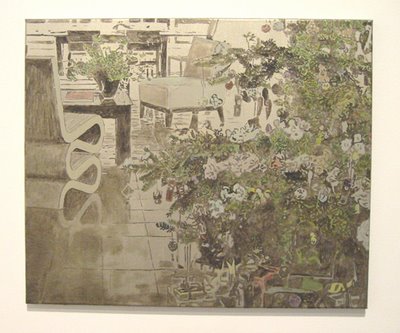 At Hosfelt Gallery, the new paintings by Stefan Kürten were mostly sold prior to the opening reception. Since each painting went for the price of a new car, this was a feat, at least for San Francisco. (Hosfelt has a New York branch, which surely helped.)
At Hosfelt Gallery, the new paintings by Stefan Kürten were mostly sold prior to the opening reception. Since each painting went for the price of a new car, this was a feat, at least for San Francisco. (Hosfelt has a New York branch, which surely helped.)The sales are a mark of Kürten's appeal. In the current show, and an earlier one in New York, I found the work seductive, but to some extent the glamour put me on guard. I wondered how much substance was beneath it. I went looking for a core.
 According to a typology once used by Isaiah Berlin in discussing Tolstoy, Kürten is a hedgehog rather than a fox. He mines one territory and doesn't gad about. His paintings typically depict a suburban home, modernist in style but evidently built years before, in a setting that contains vegetation. The homes are middle-class, or upper middle-class. The exterior of the house may be engulfed in mature plantings. Or there may be a patio with sparser plantings and modern furniture. In one case, a living room features a Wiggle Chair by Frank Gehry and, in the foreground, a loose style of Christmas tree. In another instance, a trim set of row houses is arrayed behind a miniscule set of front yards. People, animals, and incidental personal belongings are not seen.
According to a typology once used by Isaiah Berlin in discussing Tolstoy, Kürten is a hedgehog rather than a fox. He mines one territory and doesn't gad about. His paintings typically depict a suburban home, modernist in style but evidently built years before, in a setting that contains vegetation. The homes are middle-class, or upper middle-class. The exterior of the house may be engulfed in mature plantings. Or there may be a patio with sparser plantings and modern furniture. In one case, a living room features a Wiggle Chair by Frank Gehry and, in the foreground, a loose style of Christmas tree. In another instance, a trim set of row houses is arrayed behind a miniscule set of front yards. People, animals, and incidental personal belongings are not seen.The painting style has echoes of Van Gogh, Klimt, and others, but it is a particular style that is recognizably Kürten’s. Using oil on canvas, he paints thinly in colors that are muted, sometimes washed out. The ground layer is allowed to show through to varying degrees. Often the ground is gesso tinted with soft metallic paint, gold or silver. In other cases, a white ground is used. The imagery is built up with small brush strokes that mimic brick walls, shingled roofs, paving blocks, shrubbery, and so on. There is a great emphasis on patterns. There is also a fascination with the qualities of reflective surfaces, which are superbly rendered. The overall structure is firm, yet there is spontaneity in the brush strokes.
The paintings can look like illustrations from faded architectural magazines. The metallic underpainting operates like mood music to stir feelings of nostalgia. Even when the underpainting is white, the image looks vintage. The canvases could be seen as hushed memorials to safer days and tidier ideals. Less charitably, they could be viewed as sentimental.
Or perhaps the work is ironic? It might be seen as taking swipes at the 20th Century, modernist bourgeois division. The message could be "look at these ideals, they were dead ends."
There is perhaps some vamping in both directions, nostalgia and irony. But the core strength of the work lies in its invitation to contemplate. Ultimately Kürten seems more interested in evoking cultural moments than in triggering a prescribed response.
He is not a neutral observer of course. Each location that he depicts seems cut off. The houses look comfortable but deserted. The spaces are generous, but are hemmed in by strong (even psychedelic) patterns of brick, shrubs, and so forth. In some instances, a patterned sky invades the space like a hallucination, which intensifies the feeling of claustrophobia. Overall, there is pervasive tension, a sense of things at an end, and various implied questions: What happened? What next?
The work has limitations. A roomful of it can leave your wanting a fuller account. The world is so much bigger than this. And occasionally, the encoding doesn’t work—the painting devolves into a genre piece.
When Kürten is at his best, though, the results are terrific. Don’t miss the opportunity to see his work in person. Photographs can't do it justice. But I have included a few images (the first one is from the gallery website).



No comments:
Post a Comment